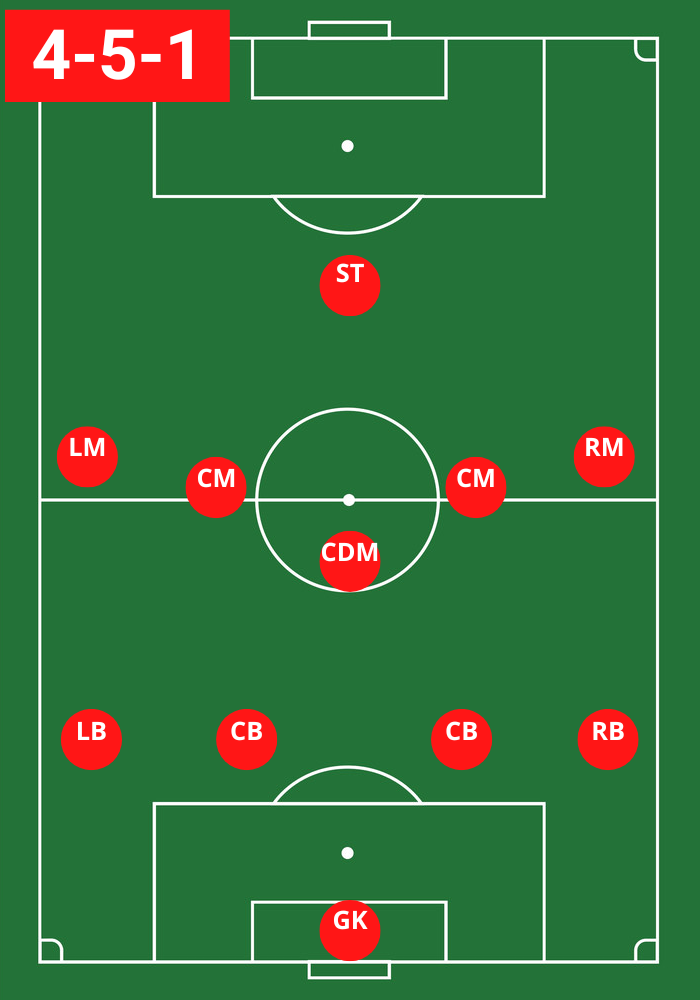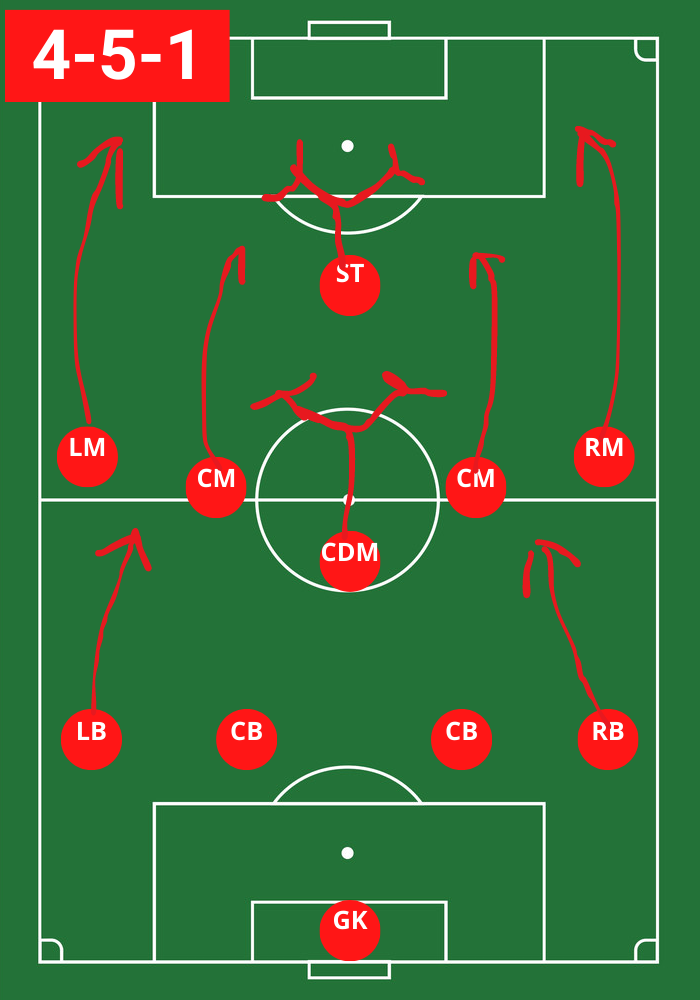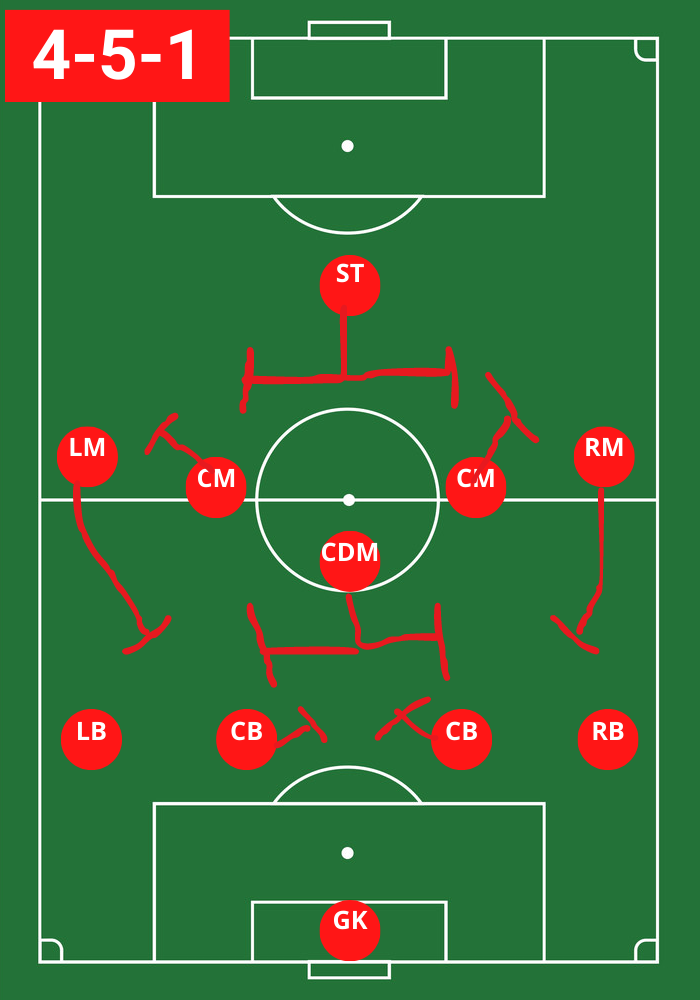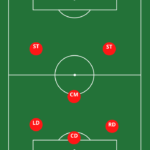- Last Updated -
The Importance of Understanding the 4-5-1 Formation
Soccer is a tactical sport, and understanding the different formations used on the pitch can greatly enhance one’s knowledge of the game.
The 4-5-1 formation is a popular strategy among coaches and teams, as it offers both offensive and defensive advantages. By having a good understanding of this formation, players can use their skills to play effectively and succeed on the field.

Explanation of the 4-5-1 Soccer Formation
The 4-5-1 soccer formation is also known as “the lone striker” formation. It consists of four defenders, five midfielders, and one lone striker upfront.
This formation is typically used by teams who want to maintain possession of the ball in midfield while also having a strong defensive presence. In this formation, the lone striker plays in an advanced position up front, with midfielders providing support behind them.
The defenders are positioned at the back to protect against opposition attacks. Teams that use this formation tend to focus on playing quick counterattacks through their midfielders who push forward when there’s an opportunity to score or exploit opposition’s defensive weaknesses.
Advantages of Understanding this Formation
Understanding how to play effectively with this formation offers several advantages for soccer players and coaches alike. One key advantage is that it provides increased control over midfield play as there are more players present in that area of the field, making it easier to hold onto possession.
Another advantage is that it allows for quick counterattacks due to having an advanced lone striker who can receive long balls from defense or pick up loose balls around midfield areas before running at defenses by themselves or with supporting midfielders.
However, there are also disadvantages such as vulnerability to counterattacks because only one player upfront may not be enough to sustain an attacking threat throughout a game. It also becomes more challenging to score goals due to the absence of a second striker that could provide an alternative option for the other players’ passing.
Understanding the 4-5-1 soccer formation is essential for anyone looking to take their soccer knowledge and playing ability to the next level. By understanding how this formation works and its advantages and disadvantages, players can use it effectively in different situations, leading their team to success on the pitch.
Overview of the Formation
Brief History and Development
The 4-5-1 soccer formation, also known as the lone striker formation, is a tactical strategy that was developed in the late 20th century. It is believed to have been first used in Italy by coach Carlo Ancelotti during his time at AC Milan in the early 2000s. The formation became popular among coaches due to its ability to provide both defensive stability and offensive opportunities.
While there were earlier formations that utilized a similar structure, like the 4-4-2 and 4-3-3, the 4-5-1 formation places more emphasis on controlling midfield play and counterattacking quickly. It allows teams to defend with five players while still having four midfielders who can support both defense and attack.
Basic Structure and Positioning
The basic structure of the 4-5-1 soccer formation consists of four defenders, five midfielders, and one striker. The goalkeeper stays in their position between the posts regardless of how many players are on the field.
The defenders are usually split into two central defenders, who are responsible for marking opposing attackers in central areas of the pitch, and two full-backs or wing-backs who operate on either side of defense. They are tasked with providing width for attacking play when required while also defending their area against opposition attacks.
In midfield, there are two central defensive midfielders (CDMs), also known as holding midfielders or “destroyers,” whose primary responsibility is to protect their backline by intercepting passes or making tackles. On either side of them are two central midfielders (CMs) whose role is more versatile – they need to contribute equally to both defense and attack.
There is one lone striker who primarily focuses on scoring goals but can also help set up attacks by holding up the ball or making runs to create space for midfielders. Their positioning is crucial, as they must remain central and close to midfielders to receive accurate passes while also trying to find space in the opposition’s defense.
Understanding the basic structure and positioning of the 4-5-1 formation is essential for any soccer enthusiast looking to gain a deeper appreciation of tactical play on the pitch. In the next section, we will discuss some of the advantages and disadvantages of using this formation in a game.


Advantages and Disadvantages
Football formations are a crucial aspect of the game, as they determine how the team will play. The 4-5-1 formation is one of the most balanced formations that can be used in football. Like any other soccer formation, it has its advantages and disadvantages.
Offensive Advantages
One of the primary advantages of using the 4-5-1 soccer formation is increased midfield control. With five midfielders, you have more players to control the ball in midfield and create chances for your forward player.
This makes it easier to keep possession and dictate the pace of the game. Another significant advantage is the ability to counterattack quickly.
When your team wins possession, you have five midfielders who can quickly move forward with speed to create scoring opportunities. This fast-paced approach can catch opposing teams off guard and lead to quick goals.
Defensive Disadvantages
However, like any other soccer formation, some disadvantages come with using this strategy as well. One of these is vulnerability to counterattacks.
With only four defenders playing behind five midfielders, it’s easier for opposing teams to launch counterattacks through gaps in your defense left by your attacking players. Another disadvantage is difficulty in scoring goals as there’s only one striker on the field upfront.
This means that he/she will often be marked by two or three defenders making it hard for them to get into a scoring position without support from their midfielders. Overall, while this formation has its advantages offensively – especially in terms of controlling possession and creating quick attack opportunities – it also has some defensive disadvantages that need consideration when choosing your lineup.
Key Roles and Responsibilities
Goalkeeper’s Role in the Formation
The goalkeeper is an essential part of any soccer team, and their role is even more crucial in the 4-5-1 formation. In this formation, the goalkeeper is responsible for commanding the defense and organizing the team from the back. They need to have good communication skills to coordinate with defenders during defensive play.
A key attribute for a goalkeeper in this formation is quick reflexes. Since only one forward player is playing upfront in opposition, it means that there will be less pressure on them.
However, that one forward can be lethal if they get past defenders, so goalkeepers need to be prepared for sudden shots on target. Additionally, since midfielders will be pushing up higher upfield to support attacks, it’s crucial that a goalkeeper can distribute the ball quickly and accurately to start counterattacks.
Defenders’ Responsibilities in the Formation
Defenders play an integral role in maintaining a strong defense line while also providing support for attacks when needed. The central defenders need to work closely together as a unit so that they can cover each other effectively and protect their goal area.
In this formation, full-backs have additional responsibilities both offensively and defensively since they’ll often overlap with midfielders who are making attacking runs upfield on either side of them. They need to time their runs well while still being able to recover back into position quickly if necessary.
Moreover, center-backs should stay alert at all times because they’ll often find themselves covering large areas of space when full-backs push ahead or midfielders move forward into attack positions. They must have excellent anticipation skills so they can read opponents’ moves early enough and neutralize threats before giving away easy chances against their team.
Midfielders’ Roles in Supporting Both Offense and Defense
Midfielders have a dual role in the 4-5-1 formation. They need to support both defense and offense, depending on the situation. In defense, they should work together to keep their opponents from advancing too far upfield while also providing cover for defenders who may be out of position.
In attack, midfielders are responsible for creating scoring opportunities by distributing balls to forwards or making runs into space themselves. They must be able to read the game well and make quick decisions based on what’s happening in front of them.
Central midfielders often have more defensive responsibilities than those playing on the wings. They need to retain possession and distribute the ball wisely while also tracking back when necessary to help out with defending.
Striker’s Role in Leading the Attack
The striker is a crucial player in any formation, but even more so in the 4-5-1 system. The lone forward needs to hold up play by keeping possession of the ball and waiting for midfielders to make supporting runs forward.
The striker needs good dribbling skills and a strong physical presence since they’ll often find themselves marked tightly by opposition center-backs throughout games. They must be able to perform under pressure and create their scoring chances through quick thinking and decisive actions.
It’s also essential that strikers stay alert at all times since they’ll be the first line of defense if their team loses possession high upfield. They must be willing to run back defensively as required so their team can maintain its shape and prevent counterattacks from opponents.
Overall, understanding each player’s role within this formation is crucial for success on the field. With good communication, teamwork, and strategy, players can work together effectively toward achieving their goals both offensively and defensively.

Tactics for Success with 4-5-1 Formation
Communication among players on positioning, passing, and movement
Communication is the key to success in any team sport and soccer is no exception. With the 4-5-1 formation, players must communicate effectively with each other on their positioning, passing, and movement. This can make all the difference in creating scoring opportunities and preventing counterattacks.
Players need to be aware of where their teammates are at all times so they can make accurate passes and maintain possession of the ball. The midfielders especially need to communicate with each other to ensure they are providing enough support both offensively and defensively.
In addition to verbal communication, players should also use nonverbal cues such as hand signals or eye contact to let their teammates know where they plan to go or what they plan to do with the ball. This level of communication takes practice but can greatly improve team performance.
Flexibility to adapt to different game situations
While having a set formation like 4-5-1 can provide structure and consistency for a team, players must remain flexible and adaptable during games. Different situations may call for different strategies or formations. For example, if the opposing team is playing aggressively in midfield, it may be necessary for more defensive-minded midfielders or even defenders to drop back and provide extra support.
On the other hand, if the opposing team is playing a more defensive game, there may be an opportunity for more attacking-minded midfielders or even forwards to push up higher on the field. Coaches should also be aware of these potential changes in strategy as well as substitutions needed based on player fatigue or injuries.
Training drills for mastering individual roles within the formation
Mastering individual roles within 4-5-1 requires both practice and discipline. Players need to be able to execute their specific responsibilities within the formation consistently and effectively. This requires a combination of physical and mental training.
Drills should focus on improving players’ positioning, passing accuracy, defensive skills, and attacking runs. Players should also practice their ability to read the game and make quick decisions based on their understanding of the team’s strategy.
Coaches should provide feedback during training sessions to help players improve their skills as well as their teamwork within the formation. This feedback can come in the form of verbal instruction or video analysis.
Success with a 4-5-1 formation requires effective communication among players, flexibility to adapt to different game situations, and disciplined training drills that focus on mastering individual roles within the formation.
While this formation can provide many offensive advantages in midfield control and counterattacks, its defensive disadvantages must be managed through proper communication and teamwork.
Ultimately, a successful soccer team is able to work together effectively towards a common goal. The 4-5-1 formation can be a great tool for achieving this when executed properly with practice and dedication from all team members.
Conclusion
Summary of key points on understanding the 4-5-1 soccer formation
Understanding the 4-5-1 soccer formation is important for players, coaches, and fans alike. This formation is widely used in professional soccer leagues around the world due to its ability to control the midfield and quickly transition from defense to offense.
The basic structure consists of four defenders, five midfielders, and one striker who work together to create scoring opportunities while also defending their own goal. The goalkeeper plays a crucial role in this formation by organizing the defense and communicating with teammates about positioning and movement on the field.
Defenders must be disciplined and focused, preventing opposing teams from breaching their backline while also being able to provide support for attacking opportunities. The midfielders play a key role in this formation by controlling possession of the ball and creating scoring chances for their striker.
They must be versatile enough to switch between offensive attacks and defensive responsibilities as needed during a game. The striker must work diligently to create opportunities for themselves through movement, hold-up play, or finishing off chances created by their teammates.
Importance of practice, teamwork, and strategy for success with this formation
To be successful with the 4-5-1 soccer formation requires practice, teamwork, and strategy. Players must understand their roles within the formation and work together seamlessly on both sides of the ball. Practicing set pieces like corner kicks or free kicks can lead to more goals scored during games.
It’s also important that each player understands how they should move during different phases of play such as transitioning from defense into attack. Teamwork is also essential when using this formation because it requires players to support each other both offensively as well as defensively.
Having a solid strategy going into games will give teams an advantage over opponents who are unprepared or not familiar with the formation. Teams should look to exploit their opponent’s weaknesses and be prepared to adapt their strategy as needed.
Overall, the 4-5-1 soccer formation is a powerful tool for teams to control possession, create scoring opportunities, and win games. With proper practice, teamwork, and strategy, any team can find success using it. (1)
How To Be A Good Soccer Parent! A Guide to Sideline Etiquette
What Makes A Good Soccer Parent? As a soccer parent, you have...
Read MoreThe Historical Dominance of Brazilian Soccer in the World Cup
Introduction: The Beautiful Game's Grandest Stage The World Cup, a grand tournament...
Read MoreIntroduction: Demystifying a Controversial Issue Soccer is a sport that requires specific...
Read MoreBox-to-Box Center Midfielder: The Engine of Modern Soccer Teams
Soccer is a game of skill, strategy, and teamwork. Every player has...
Read More



















